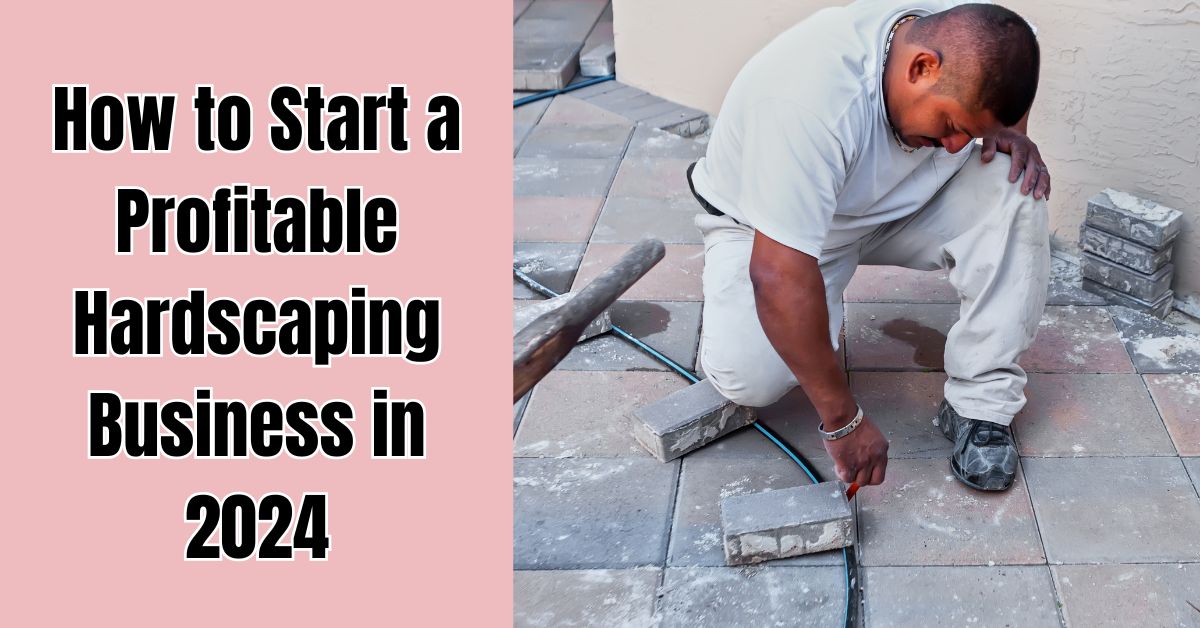Starting a hardscaping business in 2024 presents an exciting opportunity for entrepreneurs who are passionate about transforming outdoor spaces. With growing demand for customized outdoor features, from patios to walkways, the hardscaping industry continues to flourish. In this guide, we’ll walk you through the essential steps to start a profitable hardscaping business this year, ensuring you’re set for success.
Understanding Hardscaping
What is Hardscaping?
Hardscaping involves the design and installation of non-living elements in outdoor spaces. Unlike landscaping, which focuses on plants and other organic materials, hardscaping includes structures like patios, driveways, walkways, retaining walls, and outdoor kitchens. These durable features require skill in design, material selection, and construction, making hardscaping a specialized service that clients are willing to pay for.
How is Hardscaping Different from Landscaping?
While landscaping focuses on the “soft” aspects such as greenery, hardscaping is about the “hard” features. Hardscaping elements are often the foundation of a landscape, providing structure and definition. This distinction allows a hardscaping business to cater to a unique niche, offering high-ticket services to homeowners and businesses seeking to improve their outdoor areas.
Market Research
Identifying Target Customers
To succeed in the hardscaping business, it’s critical to identify your ideal customers. Are you targeting residential homeowners looking for patio upgrades, or are you aiming for commercial clients seeking to enhance outdoor business spaces? Defining your audience will help you tailor your marketing efforts.
Analyzing Local Competition
Before jumping into the market, research local competitors. What services are they offering? How are they pricing their projects? Understanding the competitive landscape helps you differentiate your services and find gaps in the market.
Hardscaping Trends in 2024
Stay ahead of industry trends by offering modern, in-demand services. In 2024, eco-friendly hardscaping, such as permeable paving and sustainable materials, is gaining traction. Clients are increasingly looking for designs that are both functional and environmentally conscious.
Creating a Business Plan
Setting Clear Business Goals
Before launching your business, define clear goals. What kind of projects do you want to work on? How much revenue do you hope to generate in the first year? Setting concrete objectives will guide your business growth and decision-making process.
Budgeting for Startup Costs
Starting a hardscaping business requires a financial investment. This includes purchasing equipment, materials, marketing, and securing necessary permits. Estimate your initial startup costs and ensure you have sufficient capital or access to funding.
Estimating Revenue and Profitability
Hardscaping projects can be highly profitable if priced correctly. Estimate your potential earnings based on project size, materials used, and labor costs. Aim to strike a balance between offering competitive pricing and ensuring your profit margins are healthy.
Essential Equipment and Materials
Must-Have Tools for Hardscaping
To start a hardscaping business, you’ll need a robust set of tools, including compactors, levels, masonry saws, and skid steer loaders. Investing in high-quality tools upfront can save time and increase efficiency on job sites.
Best Suppliers for Hardscaping Materials
Establish relationships with reliable suppliers who offer quality materials at competitive prices. Stone, brick, gravel, and pavers are the core materials for most hardscaping projects, so ensuring a steady supply is crucial.
Cost Considerations for Equipment
While high-quality tools are essential, they can also be expensive. Consider leasing equipment in the early stages of your business to manage cash flow. As your business grows, you can invest in purchasing your own equipment.
Legal Requirements and Permits
Registering Your Business
To operate legally, you must register your hardscaping business. Choose a business structure (sole proprietorship, LLC, etc.) and register it with your state or local government.
Licenses and Certifications Needed for Hardscaping
Check local regulations for licensing requirements. In some areas, you may need certifications for specific tasks like installing retaining walls or operating heavy machinery. Being certified can also boost your credibility.
Insurance and Liability Coverage
Hardscaping involves significant physical labor and the use of heavy machinery, which can pose risks. Ensure you have adequate liability insurance to protect your business from potential accidents or damages on job sites.
Building Your Hardscaping Team
Hiring Skilled Workers
As your business grows, you’ll need to hire a skilled team. Look for workers with experience in construction, masonry, or landscaping. Offering competitive wages and opportunities for growth will help you attract top talent.
Training and Development
Even experienced workers will need training in your company’s specific methods and quality standards. Invest in ongoing training to ensure your team stays up-to-date with industry practices and safety regulations.
Managing Your Team Efficiently
Managing a hardscaping crew requires clear communication and organization. Use project management software to track progress, assign tasks, and ensure projects are completed on time and within budget.
Marketing Your Hardscaping Business
Building an Online Presence
In today’s digital age, a strong online presence is crucial. Create a professional website showcasing your portfolio of completed projects, client testimonials, and contact information.
Social Media and Advertising Strategies
Leverage social media platforms like Instagram and Facebook to showcase your work and attract new clients. Paid advertising on these platforms can also help you target specific demographics in your local area.
Networking and Partnerships
Partnering with local contractors, landscapers, or architects can help you expand your client base. Networking at trade shows or joining local business associations can also lead to valuable referrals.
Pricing Your Services
How to Set Competitive Rates
To price your services competitively, research what local competitors are charging and consider your costs for materials, labor, and overhead. Offering value-added services can justify higher rates.
Offering Discounts and Promotions
In the early stages of your business, offering discounts or promotions can help attract your first clients. Be strategic, though—make sure these offers don’t cut too deeply into your profits.
Creating Packages for Larger Projects
Offering package deals for larger projects can help streamline your work and appeal to clients looking for comprehensive hardscaping solutions. Bundling services can also increase your overall revenue.
Customer Service and Retention
Ensuring High-Quality Work
Satisfied clients are the backbone of any successful business. Ensure that every project is completed to the highest standards to build a reputation for quality work.
Effective Communication with Clients
Keep clients informed throughout the project lifecycle. Regular updates, clear timelines, and transparency about any challenges will build trust and keep clients happy.
Encouraging Repeat Business
Offering maintenance services or discounts on future projects can encourage repeat business. Loyal customers can also provide word-of-mouth referrals, helping you grow your client base.
Challenges in Hardscaping Business
Dealing with Seasonal Fluctuations
Hardscaping work is often seasonal, especially in regions with harsh winters. Plan for slower periods by saving profits from busier months or offering services that can be performed year-round.
Managing Worksite Safety
Hardscaping involves heavy materials and equipment, which can pose safety risks. Ensure your team is trained in safety procedures and that job sites comply with local safety regulations.
Handling Customer Complaints
No business is immune to customer complaints. Addressing concerns quickly and professionally can turn a negative experience into a positive one.
Expanding Your Business
Diversifying Your Services
Once your business is established, consider expanding your services. This could include offering landscaping services, outdoor lighting, or water features to complement your hardscaping projects.
Scaling to Larger Projects
As your reputation grows, you may have opportunities to take on larger, more lucrative projects, such as commercial hardscaping or municipal contracts. Ensure your team and equipment can handle the increased workload.
Franchising Opportunities
If your hardscaping business is successful, you may consider franchising. This can be a way to expand into new markets without the overhead of managing multiple locations yourself.
Keeping Up with Industry Trends
Sustainable Hardscaping Solutions
In 2024, clients are increasingly looking for sustainable options. Offering eco-friendly materials and designs can set your business apart.
The Role of Technology in Hardscaping
New technologies, such as 3D design software and drone surveying, can help you deliver more accurate and efficient projects. Staying up-to-date with these tools can improve your services.
Popular Hardscaping Designs in 2024
Popular trends in hardscaping include outdoor living spaces, fire pits, and natural stone designs. Keeping up with these trends will help you meet client demands and stay competitive.
Conclusion
Starting a hardscaping business in 2024 can be both rewarding and profitable. By following the steps outlined above, you’ll be well on your way to creating a successful business that transforms outdoor spaces and delights clients.
Starting a profitable hardscaping business in 2024 requires a combination of industry knowledge, skilled labor, and a strategic approach to service offerings. To attract clients, consider diversifying your services. Offering hardscaping services in Morris County can include everything from patio installations to walkways and fire pits, adding both functionality and beauty to outdoor spaces. Additionally, incorporating specialized services like the inground pool installation process can differentiate your business by providing high-value projects. As pools are a popular addition, understanding the swimming pool installation process in NJ and offering it as a core service can attract more clients. In 2024, focusing on sustainable materials and eco-friendly designs will also appeal to environmentally conscious homeowners. With a well-rounded service portfolio and effective marketing, your hardscaping business can stand out and thrive in a competitive market.
FAQs
How much does it cost to start a hardscaping business?
The startup costs for a hardscaping business can range from $10,000 to $50,000, depending on the equipment, materials, and marketing required.
What is the most profitable type of hardscaping project?
Outdoor kitchens, patios, and retaining walls are among the most profitable hardscaping projects due to their complexity and high demand.
Do I need a certification to start a hardscaping business?
While not always required, obtaining certifications in specific areas like paver installation or heavy machinery operation can enhance your credibility.
How do I find my first customers?
Start by marketing through social media, local online directories, and by offering promotions. Networking with contractors and landscapers can also lead to referrals.
What are some common challenges for new hardscaping businesses?
Common challenges include managing seasonal fluctuations, dealing with customer complaints, and ensuring safety on job sites.

